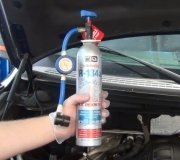A/C-HEATER CONTROL PANEL
A/C switch on A/C-heater control panel activates air conditioning system. A/C switch is a push button-type integral in blower switch.
Temperature control and function control levers are also located on A/C-heater control panel. See Fig. 1. Control panel uses standard cable operation to adjust interior air conditioning and ventilation modes.
Fig. 1: Identifying A/C-Heater Control Panel
Courtesy of FORD MOTOR CO.
LOW PRESSURE CUT-OFF SWITCH
NOTE:Low pressure cut-off switch may also be referred to as the A/C cycling switch.
Located on top of suction accumulator-drier, low pressure cut-off switch monitors refrigerant pressure and sends corresponding information to the Powertrain Control Module (PCM). The PCM allows compressor operation when refrigerant pressure increases to 46 psi (3.4 kg/cm) and stops compressor operation when refrigerant pressure decreases to 23 psi (1.6 kg/cm). When functioning properly, low pressure cut-off switch prevents evaporator icing and blockage of airflow through evaporator fins.
COMPRESSOR
A/C systems use a Nippondenso 10P13 10-cylinder axial design compressor (1.8L) and a Ford FS-10 10-cylinder swashplate design compressor (1.9L). Compressors have 5 double-acting pistons, positioned axially around compressor shaft. Pistons are actuated by a swashplate pressed onto compressor shaft. Swashplate uses shaft rotation to provide a reciprocating drive force to each of 5 pistons. This drive force is applied through balls and shoes to midpoint of each piston.
CONDENSER
Condenser is an aluminum fin heat exchanger (located in front of radiator). Condenser cools compressed refrigerant gas by allowing air to pass between its fins and tubes. As refrigerant is cooled, it condenses to a liquid state.
EVAPORATOR CORE
Evaporator core is located in evaporator/blower unit. Liquid refrigerant from fixed orifice tube enters core and cools evaporator fins. Air from blower passes through fins and is cooled and dehumidified before flowing to passenger compartment. Evaporator/blower unit is a sealed unit and should not be disassembled. If evaporator core needs to be replaced, replace evaporator/blower unit as an assembly.
FIXED ORIFICE TUBE
Fixed orifice tube is a restriction between high and low pressure liquid refrigerant. Tube meters flow of liquid refrigerant into evaporator core. System uses a Green.052" (1.32 mm) orifice tube. Fixed orifice tube is located in refrigerant line near condenser. Filter screens are positioned on tube inlet and outlet ports. "O" rings on tube body prevent liquid refrigerant from by-passing fixed orifice tube. Fixed orifice tube can be removed from A/C line and serviced.
SUCTION ACCUMULATOR-DRIER
Suction accumulator-drier is mounted on right side of firewall. Inlet tube of suction accumulator-drier is attached directly to evaporator core outlet tube.
When refrigerant enters suction accumulator-drier, heavier, oil-laden refrigerant falls to bottom of canister. A small oil bleed hole is located in side of outlet tube near bottom of canister. Bleed hole is covered by a filter and allows heavier liquid refrigerant and oil mixture to enter suction line at a controlled rate. After entering suction line, heavier liquid refrigerant and oil mixture has a second opportunity to vaporize and circulate through compressor without causing damage.
A desiccant bag is mounted inside suction accumulator-drier to absorb any moisture in refrigerant system. Low pressure cut-off switch is mounted on top of canister. A Schrader-type valve stem prevents refrigerant loss when low pressure cut-off switch is removed.
Thursday, March 18th, 2010 AT 6:20 AM



